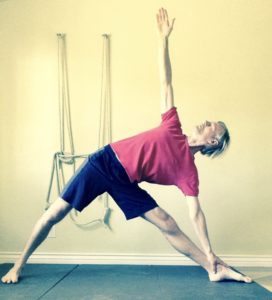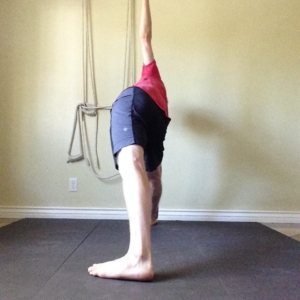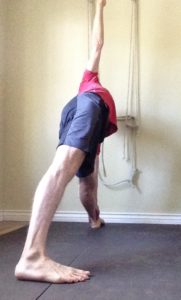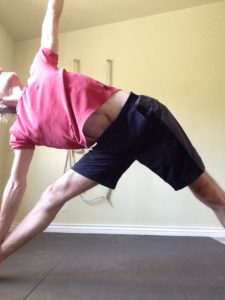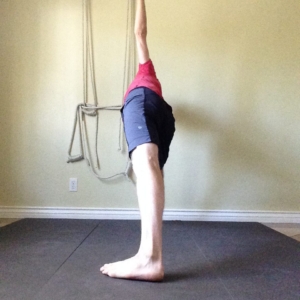Aligning the Hip for Success in Trikonasana
As the variety and number of classical yoga postures that I continue to teach and practice has decreased, my interest and enthusiasm for certain postures has only increased. Utthita Trikonasana or Extended Triangle Posture is a great example of this. I keep coming back to it and it keeps giving, providing countless opportunities for insight and reflection.
As any student of yoga knows there are as many ways to teach Trikonasana as there are teachers who teach it. This can present a challenge for the student practicing it. What should I focus on? What are the keys to this posture? What should I be doing (or not doing) to prevent injury?
Trikonasa can serve as a litmus test for low back pain and when certain mistakes are made doing it the asana can increase low back issues and even create them when they didn’t exist before. This is espeically a pitfall for yoga teachers and more experienced students who have the strength and stamina to sustain misaligned postures for longer periods. Therefore it is essential that the posture not bring up any existing pain in students who have it and that all students are attentive to executing the posture in a way that doesn’t excessively load the lumbar spine and sacroiliac joints.
I’ve discovered that a single, key early step in this posture will dramatically reduce the tendency to manifest the various problems that this posture can bring up, including low back issues, and it will greatly increase the chances of success in the posture. Basically, this step involves getting the lateral hip aligned vertically with the outer ankle bone.
Notice in the photo to the left (Figure 1) how the my left hip joint (both hips really) is pushed forward of my ankle. This results in a laxity of the muscles in the lateral hip, leaving the muscular support of this hip much to the quadriceps and the forefoot and results in excessive load on the hip and knee joints and a significant misalignment of my spine.
Often accompanying the hip forward is the lower ribcage which tends to shear forward of the lumbar spine (Figure 2). When the ribs shear forward this way, any turn of the rib cage and chest must come primarily from the lumbar spine and will tend to accelerate the hips even more forward, excessively loading the lower back and increasing the load on the hip even further.
Look at how my rib cage in the photo below (Figure 3) reveals the excessive arch in my low back. As I twist to the left, the arching of the back will only increase along with the load on the spine.
Bringing my hip back in line with my ankle bone, or at least closer to it, will go a long way toward resolving these issues.
First, it immediately reduces load on the quadriceps and the anterior hip, reducing stress on the hip and knee joints.
Second, it allows me to relax the gluteus maximus of my front leg hip, making it easier to upright the pelvis and give greater space to the lower lumbar vertebra and sacroiliac joints.
Third, with the added length in the lower back it’s now possible for me to release the rib cage back into a more optimal alignment with the pelvis, further reducing stress on the back. You can see these changes on my Trikonasana in the photo below (Figure 4).
With the hip back in alignment I can initiate the twisting action in the posture from the pelvis, incorporate more abduction in my front hip and reduce the demand on my spine for providing the bulk of the rotation. This alignment will also help to involve my front leg more in the twist for better distribution of loads between the two legs.
Along with optimizing the alignment of the ribcage with the pelvis I have reduced a lot of the load to my lower back and SI joints in this posture and redistributed it into my pelvic floor and legs. Now with the spine communicating directly with my legs I can generate more length through the whole spine and up into the chest and arms and really bring the pose to life!
Overall, bringing my hip back distributes more of the loads in this posture into more places. This improved load distribution serves to strengthen and increase blood and lymph flow to tissues throughout the body and contrasts starkly with a posture that simply overloads the hips, knees and lower back. That’s the difference between a posture that brings health to the body and one that only serves to wear it down.

